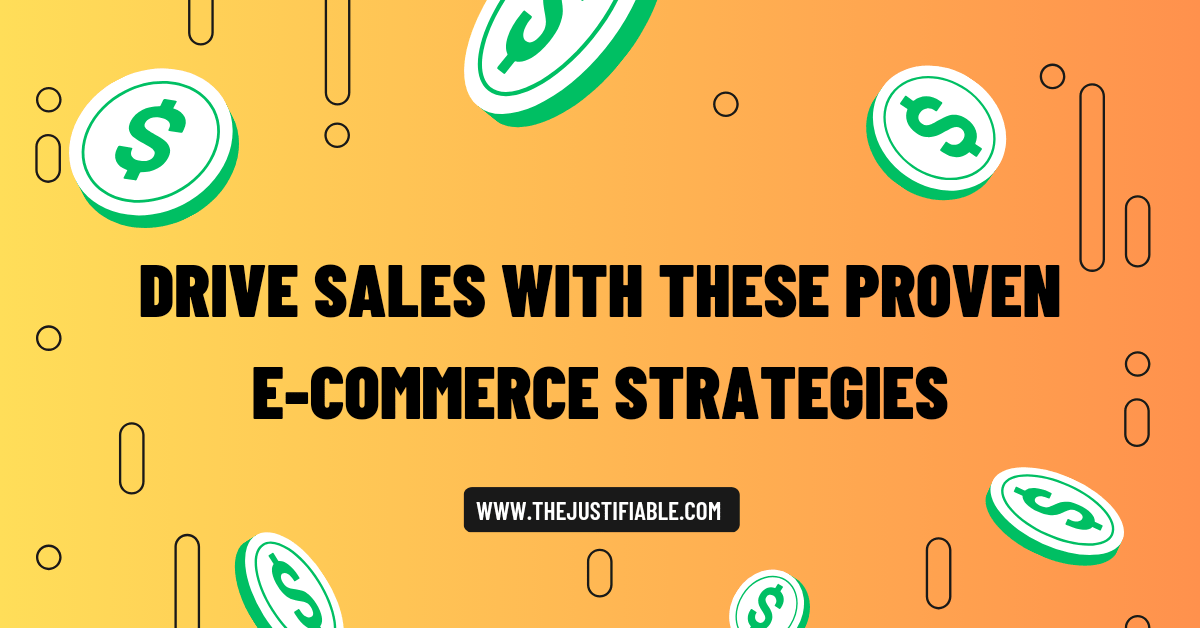In today’s digitally driven world, e-commerce is more than just a trend; it’s a dominant force shaping the way consumers shop and businesses operate. Being able to effectively drive sales in this landscape is crucial for any e commerce enterprise aiming for long-term success.
While various strategies can be employed, understanding the core principles that influence sales and customer behavior is essential. This article seeks to enlighten its readers about the foundational aspects of e-commerce sales and how mastering these elements can significantly boost your bottom line.
Understanding the Fundamentals of E-commerce Sales
Before diving into intricate strategies to drive sales, one must first comprehend the basics. A successful e-commerce platform rests on two pillars: drawing potential customers in (traffic) and then convincing them to make a purchase (conversion). Let’s explore these two aspects in more detail.
The relationship between traffic and conversion.
Driving traffic to your e-commerce website is akin to attracting footfall in a physical store. However, high traffic alone does not guarantee high sales. It’s the quality and intent of this traffic that truly matters.
For instance, a website may receive thousands of daily visitors, but if they aren’t interested in the products offered or if they find the site difficult to navigate, they’re unlikely to convert into customers.
Conversion, on the other hand, pertains to the ability of your platform to persuade this traffic to make a purchase. Conversion rate optimization (CRO) strategies focus on enhancing the user experience to increase the likelihood of a sale.
The symbiotic relationship between traffic and conversion is evident: quality traffic offers a higher potential for conversion, and a streamlined conversion process can further capitalize on this traffic to drive sales.
Key performance indicators (KPIs) to monitor.
Monitoring the right KPIs provides insights into how effectively you’re driving sales and where improvements can be made. Here are some essential e-commerce KPIs to keep an eye on:
- Conversion Rate: This metric represents the percentage of visitors who make a purchase. A higher conversion rate indicates an effective sales strategy and user-friendly website.
- Average Order Value (AOV): This gives insights into the average amount spent by customers per transaction. Increasing AOV can greatly enhance overall revenue without necessarily increasing traffic.
- Cart Abandonment Rate: A high rate indicates potential friction points in the checkout process that deter customers from completing their purchase.
- Customer Lifetime Value (CLV): This measures the total revenue a single customer is expected to generate over the course of their relationship with your brand. It helps in strategizing long-term engagement and loyalty-building initiatives.
- Return on Advertising Spend (ROAS): This metric evaluates the effectiveness of your advertising campaigns in generating sales.
Regularly monitoring and analyzing these KPIs can provide a clearer picture of your e-commerce platform’s performance and areas that require attention.
Strategies to Drive Sales in Your E-commerce Business
The e-commerce arena is bustling with opportunities. Yet, to tap into its full potential and drive sales, businesses must be strategic and deliberate in their approach.
From the design of your website to the engagement tactics you employ, every aspect plays a pivotal role in influencing consumer decisions. Below, we’ll delve into some proven strategies that can give your e-commerce business a competitive edge and significantly drive sales.
Implementing a user-friendly website design
First impressions matter. When visitors land on your e-commerce site, the design is the initial factor they’ll engage with. A clean, intuitive, and responsive design not only enhances the user experience but also builds trust. Here are some aspects to focus on:
- Mobile Optimization: With a significant number of consumers shopping via mobile, ensure your design is mobile-friendly.
- Load Times: A lagging website can deter potential customers. Optimize images and use effective caching to enhance speed.
- Intuitive Navigation: Users should effortlessly find what they’re looking for. Implement clear categories, filters, and search functions.
By prioritizing a user-centric design, businesses can drive sales by retaining visitors and enhancing their shopping journey.
Leveraging email marketing campaigns
In the digital age, email remains one of the most potent tools to drive sales. Personalized email campaigns can yield impressive returns by:
- Segmenting Lists: Tailor content based on purchase history, interests, and behavior.
- Cart Abandonment Reminders: Gently remind users of products they’ve left behind, perhaps offering a discount or incentive.
- Newsletters: Regular updates about new products, sales, or company news can keep your brand top-of-mind.
Through strategic email marketing, businesses can re-engage past customers and drive sales from potential ones.
Incorporating social proof and reviews
Trust is a cornerstone of e-commerce success. Incorporating social proof and genuine customer reviews can significantly drive sales by:
- Highlighting Testimonials: Showcase positive feedback on product pages and the homepage.
- Using User-Generated Content: Photos of real customers using your products can instill trust and desire.
- Responding to Negative Reviews: Address concerns, showing you value feedback and customer satisfaction.
Such strategies validate the quality of your products, assuring potential customers and nudging them towards a purchase.
Upselling and cross-selling techniques
Boosting the average transaction value can effectively drive sales. Upselling and cross-selling are tactics where you encourage customers to purchase a higher-end product or complement their existing choice.
- Product Recommendations: Display related or premium products on product pages and during the checkout process.
- Bundle Deals: Offer discounts for products that are often bought together.
These techniques not only drive sales but enhance the customer’s shopping experience, offering them valuable suggestions.
Streamlining the checkout process
A complicated checkout process can deter even the most eager shoppers. To drive sales, it’s essential to remove any friction during the final steps:
- Guest Checkouts: Allow users to make purchases without creating an account.
- Multiple Payment Options: Cater to varied payment preferences, from credit cards to digital wallets.
- Transparent Shipping and Returns: Clearly state shipping costs, times, and return policies.
By simplifying the checkout process, businesses can prevent cart abandonment and ensure that the sales journey concludes successfully.
Utilizing Advanced Technology to Drive Sales
In a rapidly evolving digital landscape, leveraging the latest technologies is no longer an option but a necessity for e-commerce businesses.
Advanced technologies not only revolutionize the way customers interact with online platforms but also enhance their shopping journey, increasing the chances of conversion. Let’s explore how certain pioneering technologies can drive sales and set your e-commerce venture apart.
Augmented reality (AR) and virtual reality (VR) in e-commerce: Enhancing user experience to boost sales
Gone are the days when consumers were content with just images or videos of products. AR and VR have transformed online shopping into an immersive experience. Here’s how:
- Virtual Try-Ons: With AR, customers can virtually try on items like glasses, jewelry, or apparel, reducing return rates and boosting confidence in purchases.
- 3D Product Visualization: VR enables users to explore products in 3D, appreciating details that traditional images might miss.
- Interactive Storefronts: Virtual stores where customers can “walk” and browse, replicating the in-store experience, can drive sales by engaging users more deeply.
Integrating AR and VR can bridge the experiential gap between online and offline shopping, compelling users to finalize their purchases.
Chatbots and AI-driven customer support: Assisting shoppers and driving sales with instant answers
The power of instant communication in e-commerce cannot be understated. Chatbots and AI-driven support provide:
- 24/7 Assistance: Bots can answer queries round the clock, ensuring customers get timely information.
- Product Recommendations: AI can analyze user behavior and queries to suggest products, driving sales.
- Reduced Cart Abandonment: Instant solutions to checkout queries can prevent customers from leaving the site.
Employing AI-driven support not only streamlines customer service but also personalizes the shopping experience, influencing purchase decisions.
Personalized shopping experiences: Using data analytics to recommend products and increase sales
Personalization has emerged as a key differentiator in e-commerce. Data analytics play a crucial role in tailoring unique shopping experiences:
- Behavior Analysis: By tracking user activity, businesses can understand preferences and shopping habits.
- Tailored Marketing: Send targeted email campaigns or ads based on previous interactions, increasing the chances of sales.
- Dynamic Content Display: Show products or deals on the homepage based on a user’s browsing history.
A personalized touch makes customers feel valued, and when combined with data-driven product recommendations, it can significantly drive sales by presenting users with exactly what they’re looking for or didn’t even know they wanted.
Adapting to Changing Consumer Behaviors
The world of e-commerce is as dynamic as the consumers it serves. As technology evolves and societal values shift, so do the behaviors and expectations of online shoppers. Understanding and adapting to these changes isn’t just about staying relevant; it’s a vital strategy to drive sales and thrive in an ever-competitive market.
Mobile optimization for e-commerce: How mobile sales can surpass desktop sales
Mobile devices have become indispensable tools in our daily lives, influencing not only how we communicate but also how we shop. Mobile optimization is no longer optional for e-commerce businesses; it’s essential.
- Convenience on the Go: Mobile shopping allows consumers to make purchases anytime, anywhere, fitting seamlessly into their on-the-move lifestyles.
- Improved Mobile Payment Systems: With innovations like Apple Pay and Google Wallet, mobile transactions are becoming faster and more secure.
- Adaptive Design: Ensuring your website is mobile-responsive increases engagement, as users are less likely to leave a site that displays and functions well on their device.
Mobile sales have seen a meteoric rise, and by focusing on mobile optimization, e-commerce businesses can tap into a growing market segment, potentially surpassing desktop sales.
Offering flexible payment options: Catering to varied financial preferences to drive sales
Financial flexibility has emerged as a significant factor influencing purchasing decisions in the e-commerce space.
- Credit, Debit, and Digital Wallets: By providing multiple payment methods, businesses can cater to a wider audience, ensuring that transaction preferences aren’t a barrier.
- Buy Now, Pay Later: Offering installment-based payment options can drive sales by making products more accessible to those wary of immediate expenses.
- Cryptocurrency Payments: As digital currencies gain traction, integrating them can appeal to a tech-savvy audience.
When consumers find a payment method they’re comfortable with, they’re more likely to finalize their purchases, driving sales.
Sustainability and ethical practices: How they influence modern consumers’ buying decisions
Modern consumers are increasingly conscientious, often prioritizing businesses that align with their values.
- Ethical Production: Transparently showcasing sustainable manufacturing processes can build trust and loyalty.
- Eco-friendly Packaging: Reducing plastic and using recyclable materials appeal to environmentally conscious consumers.
- Fair Trade and Worker Welfare: Consumers are willing to support businesses that ensure fair wages and good working conditions.
Incorporating and promoting sustainable and ethical practices isn’t just good for the planet and its inhabitants; it’s becoming a significant influencer in consumers’ buying decisions.
Conclusion
E-commerce is a realm of boundless opportunities, but to truly harness its potential, businesses must be attuned to the evolving landscape. From technology shifts like mobile optimization to societal changes emphasizing sustainability, adapting to these dynamics is paramount.
To drive sales in e-commerce, understanding and meeting consumers’ ever-changing needs and expectations is essential. As we move forward, continuous adaptation, learning, and a keen ear to the ground will be the cornerstones of sustained growth and success.






